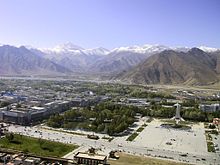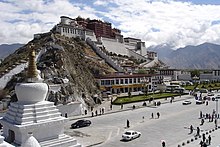Potala Palace
| Tibetan name |
|---|
|
Tibetan script :
པོ་ ཏ་ ལ་
|
|
Wylie transliteration : po ta la
|
|
Pronunciation in IPA : [
potala ]
|
|
Official transcription of the PRCh : Bodala
|
|
THDL transcription : Potala
|
|
Other spellings: -
|
| Chinese name |
|
Traditional :
布達拉宮
|
|
Simplified :
布达拉宫
|
|
Pinyin : Bùdálā Gōng
|
The Potala Palace ( Tibetan ཕོ་བྲང་ པོ་ ཏ་ ལ Wylie pho brang po ta la , named after Potala , the pure land of the Bodhisattva Avalokiteshvara ) in Lhasa was Ganden Phodrang during the time of the central Tibetan government (Tib. དགའ་ ལྡན ་ ཕོ་ བྲང, dga 'ldan pho brang ; ruled from 1642 to 1959) official residence and seat of government of the Dalai Lamas . The huge palace is located on the mountain "Mar-po-ri" (Tib .: དམར་པོ་ རི, dmar po ri ; "Red Mountain"), which rises 130 meters above Lhasa, the capital of the autonomous Tibetan region .
history
The first palace was built in 637 by Songtsen Gampo for his wife Wen Cheng on the "Red Mountain" in Lhasa . The palace was completed in 641. In the 8th century, Chinese troops largely destroyed it.
In the 17th century the 5th Dalai Lama ordered the construction of a palace on the "Red Mountain". The remains of Songtsen Gampo's palace were integrated into the construction of the larger complex. The construction of the first part of today's palace, the “Phodrang Karpo” (Tib .: pho brang dkar po ; “White Palace”), was completed in 1648 under the rule of the 5th Dalai Lama, the “Phodrang Marpo” (Tib .: pho brang dmar po ; "Red Palace") was not completed until 1694 after his death under Desi Sanggye Gyatsho . There is a detailed report from the regent for this construction phase with an extensive list of the Newar craftsmen who were involved in the construction. The last major change took place in 1922. Several rooms were renovated under the 13th Dalai Lama and two more floors were added to the Red Palace.
With the construction of the Norbulingka , which from then on was used as a summer palace, the Potala was given the name "Winter Palace".
The Potala Palace survived the Chinese Cultural Revolution as one of the few cultural monuments in Tibet comparatively unscathed, as the palace had to serve as accommodation for the Chinese occupation army. Today it is used as a museum, but next to the Jokhang Temple it is still one of the most important pilgrimage sites for Tibetan Buddhists.

The Potala Palace has been on the list of monuments of the People's Republic of China (1-107) since 1961 . Since 1994 the "Potala Palace Historical Ensemble in Lhasa" has been on the UNESCO list of world heritage sites as a world cultural monument . In addition to the Potala Palace, the ensemble also includes the Norbulingka Summer Palace and the Jokhang Temple. In 2004, the Tibet Autonomous Region government invested 70 million yuan (about 7 million euros) in renovating the Potala, Norbulingka and Sa'gya monasteries.
architecture
The palace extends in an east-west direction for about 350 meters and in a north-south direction for 300 meters. The complex has 999 rooms on 13 floors.
The Dalai Lama's private rooms are on the top floors of the Red Palace. In addition to large ceremonial and meditation halls and many smaller chapels, the complex also contains the grave chortens of the previous reincarnations of the Dalai Lama. Eight Dalai Lamas were buried in their own tombs, starting with the 5th Dalai Lama, whose tomb is the most magnificent. For this purpose, approx. 3700 kilograms of gold were processed at a height of 17.4 meters over three floors.
literature
- Deng Tu: The Potala Palace . Chinese Esperanto Publishing House 1995, ISBN 7-5052-0244-8 .
- Àiěrjídì 艾尔 极地: Dài nǐ yóu Bùdálá Gōng带 你 游 布达拉宫 / Follow Me to the Potala . Sìchuān měishù chūbǎnshè 四川 美术 出版社 2001, ISBN 7-5410-1940-2 .
- The Potala Palace of Tibet . Joint Publishing Company 1982, ISBN 962-04-0196-4 .
- Anthony Guise: The Potala of Tibet . Atlantic Highlands / Stacey International 1988, ISBN 0-905743-48-2 .
- Phuntsok Namgyal: Splendor of Tibet, The Potala Palace . Homa & Sekey 2002, ISBN 1-931907-02-1 .
Web links
- thdl.org: Potala ( Memento from May 18, 2008 in the Internet Archive ) (English)
- Entry on the UNESCO World Heritage Center website ( English and French ).
- Potala palace. Tibet travel expert
Individual evidence
- ^ Terese Tse Bartholomew: Life in Lhasa. In: Vickie C. Byrd, Kathie A. Hamilton, Nancy R. Johnson (eds.): Tibet: Treasures from the roof of the world. Exhibition catalog. Bowers Museum, Tibet Museum, Asian Art Museum, Santa Ana (California), 2003, ISBN 0967961246 , p. 201.
- ↑ Klemens Ludwig: Tibet. CH Beck, Munich, 4th edition, 2006, ISBN 978-3-406-46224-5 .
- ↑ China 2006 . Publishing house for foreign language literature, Beijing, 2003, ISBN 7-119-04426-5 , p. 238.
| Potala Palace (alternative names of the lemma) |
|---|
| Phodrang Potala (pho brang po ta la); Tse Phodrang (rtse pho brang); Potala Podrang; Tse Podrang |
Coordinates: 29 ° 39 ′ 28 ″ N , 91 ° 7 ′ 1 ″ E



